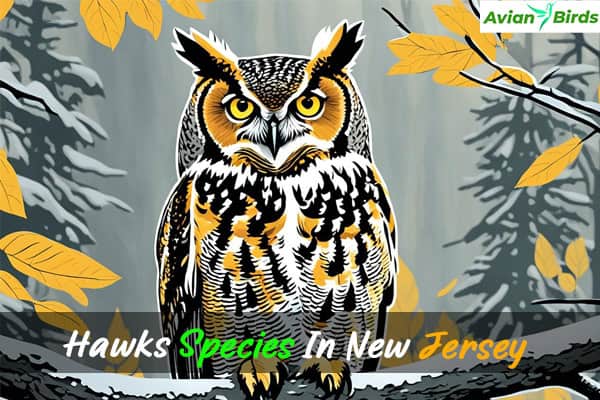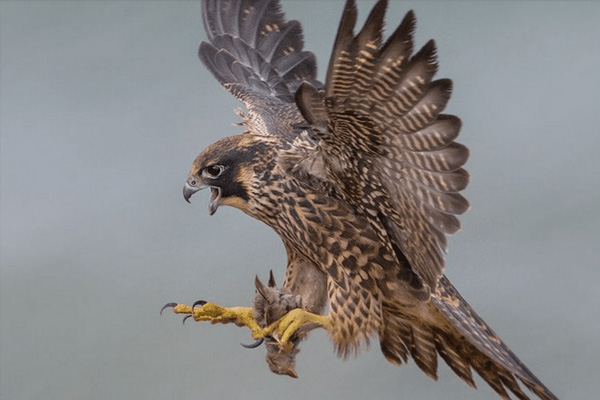Woodpeckers in Montana (10 Species With Pictures)
Ever wondered about the woodpeckers in Montana? This state is a haven for these amazing birds, with ten species calling it home. From the tiny Downy Woodpecker to the large Pileated Woodpecker, each plays a key role in Montana’s ecosystems. Join us as we explore the world of woodpeckers in Montana and discover pictures of these 10 species.
Common Woodpecker Species In Montana
- Downy Woodpecker
- Hairy Woodpecker
- Pileated Woodpecker
- Northern Flicker
- Red-Headed Woodpecker
- Red-Naped Sapsucker
- Black-Backed Woodpecker
- American Three-Toed Woodpecker
- Williamson’s Sapsucker
- Lewis’s Woodpecker
1. Downy Woodpecker
- Scientific name – Dryobates pubescens
- Lifespan – 11 years (maximum recorded)
- Size – 6.3 inches
- Weight – 0.9 oz
- Wingspan – 11 inches
The downy woodpecker is a small bird often seen in trees near your home. It’s the smallest woodpecker in North America, making it fun to watch. Also, They stand out with their black and white feathers.

Habitat and Behavior
Downy woodpeckers live in Montana all year, in places like deciduous forests and woodland edges. They visit bird feeders in winter and join other birds in search of food. They make a unique drumming sound and say a short, sharp “pik”.
These woodpeckers are lively and colorful, adding joy to Montana’s bird scene. Watching them in your backyard or a park is always a treat.
2. Hairy Woodpecker
- Scientific name – Leuconotopicus villosus
- Lifespan – 15 years (maximum recorded)
- Size – 8.6 inches
- Weight – 2.4 oz
- Wingspan – 14.5 inches
The hairy woodpecker is similar to the downy woodpecker but has distinct differences. It is bigger and has a longer bill. Yet, it can be hard to tell them apart quickly. A good way to spot the difference is by looking at their tail feathers. The downy woodpecker has spotted feathers, while the hairy woodpeckers are plain white.

Hairy woodpeckers come in different sizes and colors across their subspecies. Those in the north are usually bigger, and their belly colors vary from white to a dirty-brown. The eastern hairy woodpeckers have thicker facial stripes and more spots than those in the west.
They make a sharp, low-pitched “peek” sound and a rattling whinny. These sounds, along with their size and tail feathers, help tell them apart from downy woodpeckers when identifying hairy woodpeckers.
3. Pileated Woodpecker
- Scientific name – Dryocopus pileatus
- Lifespan – 12 years (maximum recorded)
- Size – 17,5 inches
- Weight – 11 oz
- Wingspan – 28 inches
The pileated woodpecker is a sight to see in Montana’s forests. It’s the biggest woodpecker in North America. It has black and white feathers and a bright red crest. Males have a red stripe on their throat too.
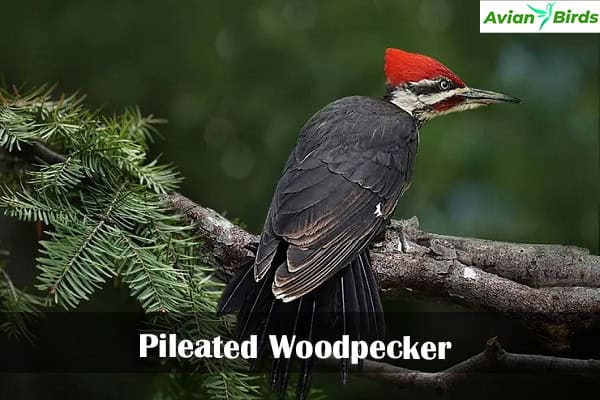
These birds love the mature forests of western Montana. They live in hardwood, deciduous, and mixed forests. You can spot them on big, dead trees, digging for carpenter ants and other insects with their strong beaks.
Pileated woodpeckers are key to their ecosystem. They hunt and also make homes for other birds and small mammals. Their survival shows how healthy Montana’s forests are. Wildlife experts keep a close watch on them because they’re sensitive to logging and losing their homes.
When you’re walking in the woods or birdwatching at home, look for the pileated woodpecker. It’s the biggest in Montana and very important to the state’s birds. Its looks and role in nature make it a special bird.
4. Northern Flicker
- Scientific name – Colaptes auratus
- Lifespan – 9 years (maximum recorded)
- Size – (32 cm)
- Weight – (126.5 g)
- Wingspan – (48 cm)
The northern flicker Woodpeckers In Montana, also known as the common flicker, is a medium-sized woodpecker found in Montana. It belongs to the Colaptes genus in the woodpecker family. Its brown, black, and beige feathers make it easy to spot.

Unique Characteristics
This woodpecker stands out with its brown upperparts and black bars. Its underside is beige with black spots and a unique black crescent on the upper breast. In flight, its white rump is very noticeable.
Male northern flickers have red stripes from their bill’s base, looking like a mustache. Their call sounds like a “ki ki ki” cackle.
Habitat and Diet
Northern flickers live in many places in Montana. They like open woodlands, forest edges, and even suburban areas. They’re also found near wetlands, swamps, marshes, and open fields with trees.
They often nest in holes made by other birds. These woodpeckers eat insects like beetles, ants, and larvae. They also eat plant stuff like seeds, fruit, and berries, including those from poison ivy and oak.
5. Red-Headed Woodpecker
- Scientific name – Melanerpes erythrocephalus
- Lifespan – 9 years (maximum recorded)
- Size – (22 cm)
- Weight – (76 g)
- Wingspan – (42.5 cm)
If you love birdwatching in Montana, watch for the red-headed woodpecker. Also, This bird stands out with its black, white, and bright red feathers. It has white underparts, black back and wings, and a red head and neck.
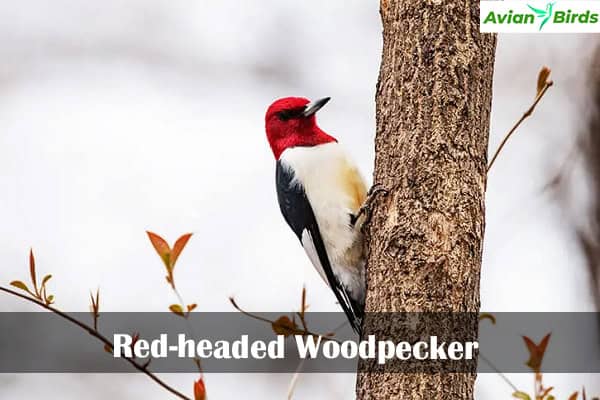
The red-headed woodpecker looks a lot like the red-bellied woodpecker. Young birds have a grey head instead of red. They live in many places like forests, farmlands, and even burned areas.
In spring and summer, you’ll see them in eastern Montana, especially in open woods. Also, They live in forests all year, making them easy to spot. The red-headed woodpecker is a favorite among birdwatchers in Montana.
6. Red-Naped Sapsucker
- Scientific name – Sphyrapicus nuchalis
- Lifespan – 4 years (maximum recorded)
- Size – (20 cm)
- Weight – (49 g)
- Wingspan – (42 cm)
The red-naped sapsucker is common in Montana. These birds make small holes in tree trunks and limbs. They create “wells” for the sap to flow.
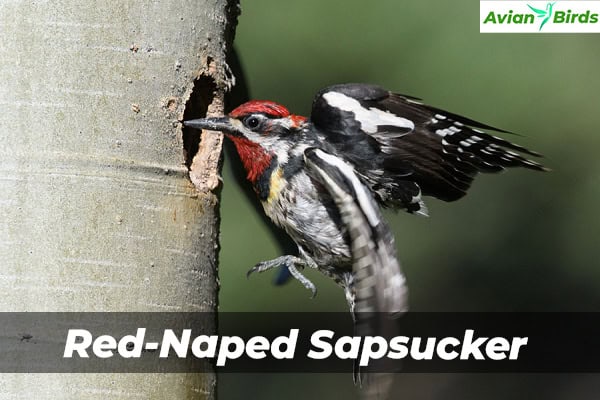
They return to these wells all day to drink the sap and catch insects in it.
Other Woodpecker Species
Montana is home to many woodpeckers, not just the common ones. The black-backed woodpecker, American three-toed woodpecker, and Lewis’s woodpecker make the state’s bird life diverse.
7. Black-Backed Woodpecker
- Scientific name – Picoides arcticus
- Lifespan – 8 years (maximum recorded)
- Size – (23 cm)
- Weight – (74.5 g)
- Wingspan – (41 cm)
The black-backed woodpecker lives in burned forests. It has a black back and wings, making it hard to see in charred trees. This lets it survive in areas hit by wildfires.

8. American Three-Toed Woodpecker
- Scientific name – Picoides dorsalis
- Lifespan – 6 years
- Size – 8.3 inches
- Weight – 1.9 oz
- Wingspan – 15 inches
The American three-toed woodpecker stands out with only three toes. This helps it grip tree trunks while looking for insects. It lives in Montana’s pine forests.

9. Lewis’s Woodpecker
- Scientific name – Melanerpes lewis
- Lifespan – 10 years (maximum recorded)
- Size – 10.6 inches
- Weight – 4 oz
- Wingspan – 19.9 inches
Lewis’s woodpecker is unique. It doesn’t peck on trees like other woodpeckers. Instead, it flies out to catch insects in the air. This makes it different from other woodpeckers in Montana.

10. Williamson’s Sapsucker
- Scientific name – Sphyrapicus thyroideus
- Lifespan – Unknown
- Size – 9 in
- Weight – 1.8 oz
- Wingspan – 17 in
The Williamson’s sapsucker is less common but just as interesting. The male has a black back, white wing patch, red throat, and yellow belly. The female looks like a Northern Flicker with a brown head and barred body.

These sapsuckers live in dry, open forests in the mountains. They often nest in aspens or larch trees.
Seeing a red-naped or Williamson’s sapsucker in Montana is special. It’s a chance to watch these hardworking birds tap into trees for a sweet snack.
Check Our Previous Articles:
Spotting Woodpeckers in Montana
Montana is a great place for spotting woodpeckers. Each woodpecker has its look that makes it easy to tell apart. Whether you love birdwatching or just enjoy nature, learning to spot woodpeckers in Montana is exciting. You’ll find everything from the small Downy Woodpecker to the big Pileated Woodpecker in different places around the state.
Spotting woodpeckers is easy when you notice their unique flight. They fly in an undulating way, folding their wings during quick beats. This flight pattern sets them apart from other birds as they move between trees to find food.
Woodpeckers also have special feet with two toes pointing forward and two backward. This lets them cling to tree trunks and branches easily. So, it’s easier to see them as they drill, drum, and search for food.
In Montana, you might see woodpeckers like the Downy, Hairy, Northern Flicker, and Pileated Woodpecker. Each type has its own look, size, and favorite places to hang out. Learning to identify them can be a fun challenge for bird lovers.
Wrapping Up…
Montana is home to a wide variety of woodpeckers, from the tiny Downy Woodpecker to the large Pileated Woodpecker. These birds are a treat for anyone who loves birdwatching or nature. By learning about their unique traits, you can spot and enjoy them on your next outdoor trip to Montana.
When you’re in Glacier National Park, visiting wildlife refuges, or just enjoying your backyard, watch for the woodpeckers. They’re easy to spot because of their loud drumming and bright colors. These birds are important to the ecosystem. They make homes for themselves and help other birds by finding food.
This guide has given you tips on finding and enjoying Montana’s woodpeckers. So, go outside, listen to the drumming, and start your adventure of discovering woodpeckers in the American West.



